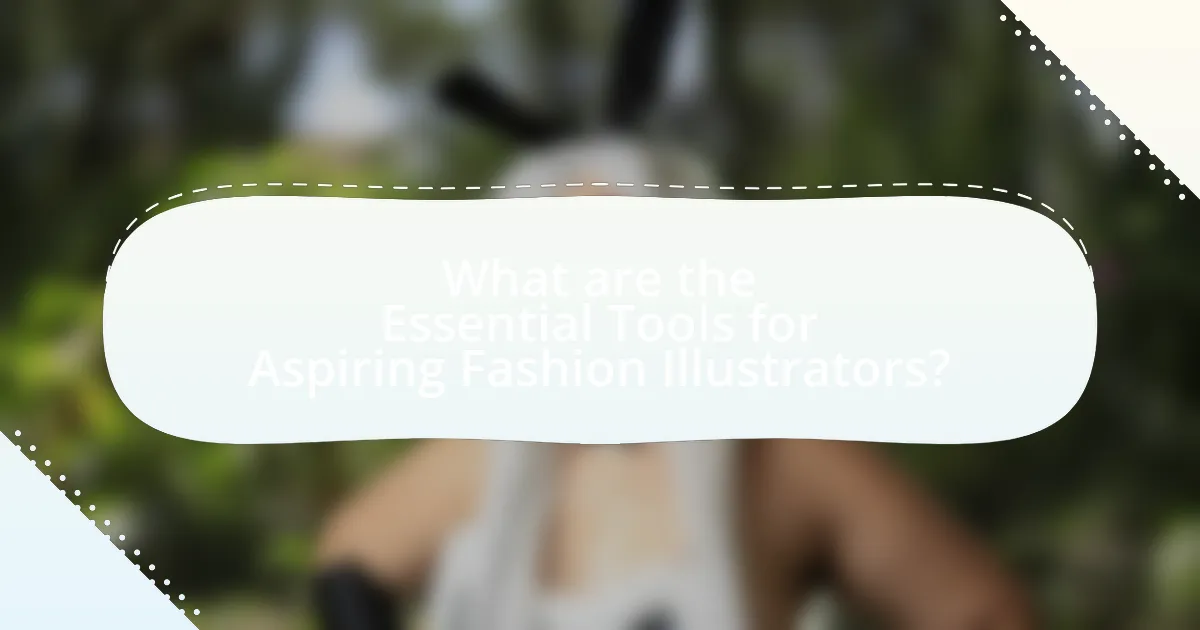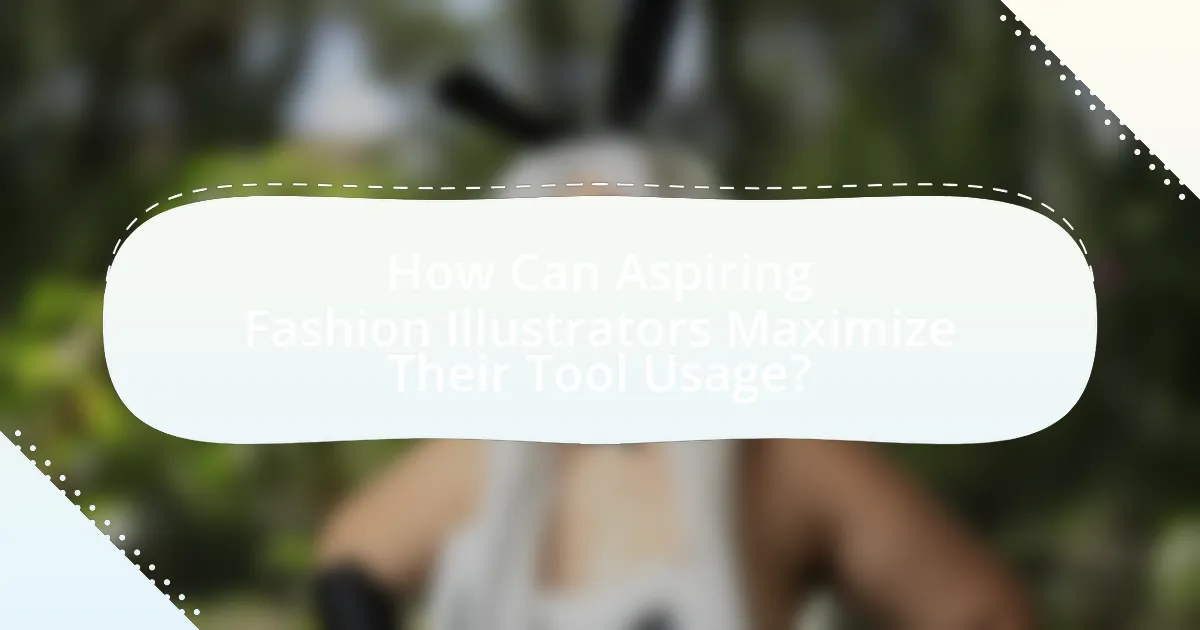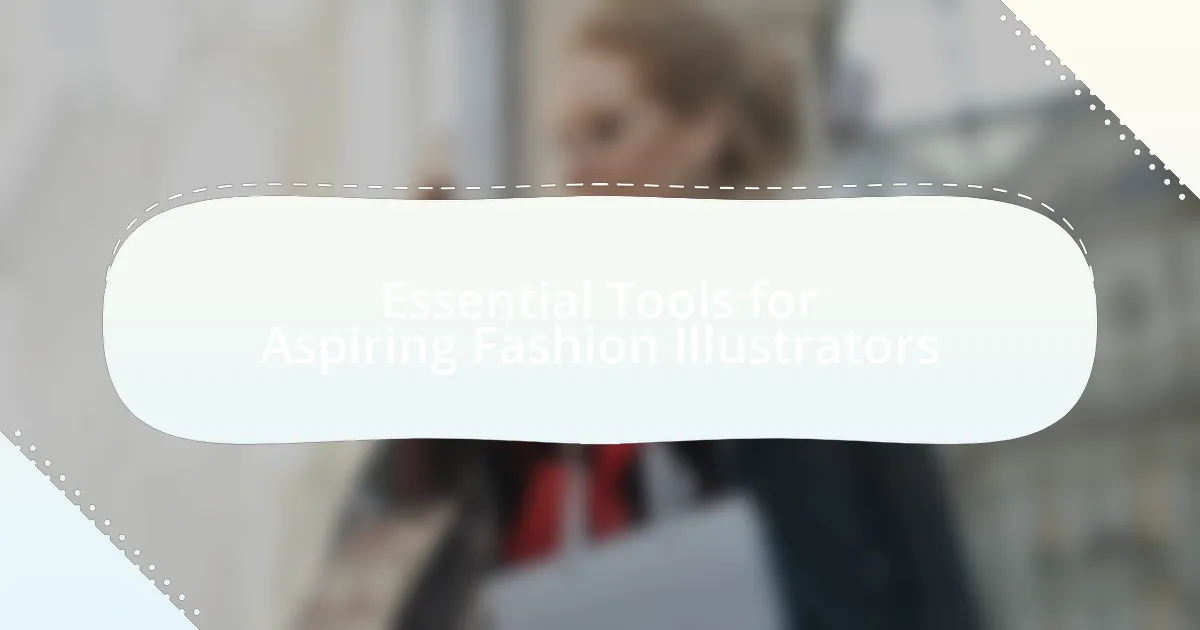The article focuses on the essential tools for aspiring fashion illustrators, highlighting the importance of high-quality sketchbooks, a variety of drawing pencils, markers, and digital illustration software. It emphasizes how the right tools enhance the quality, efficiency, and creativity of fashion illustrations, while also categorizing tools into traditional materials, digital software, and presentation tools. Additionally, the article discusses the impact of tool quality on artistic output, the advantages of specific brands, and practical tips for selecting and maintaining illustration tools. Resources for learning about these tools and techniques are also provided, supporting the development of skills in fashion illustration.

What are the Essential Tools for Aspiring Fashion Illustrators?
The essential tools for aspiring fashion illustrators include high-quality sketchbooks, a variety of drawing pencils, markers, and digital illustration software. High-quality sketchbooks provide a durable surface for practice and experimentation, while a range of drawing pencils allows for different shading techniques and line qualities. Markers, particularly alcohol-based ones, are favored for their vibrant colors and blending capabilities. Digital illustration software, such as Adobe Illustrator or Procreate, enables illustrators to create polished, professional designs and easily share their work. These tools are fundamental for developing skills and producing compelling fashion illustrations.
Why is having the right tools important for fashion illustration?
Having the right tools is crucial for fashion illustration because they directly impact the quality and efficiency of the artwork produced. Quality tools, such as professional-grade markers, pencils, and digital software, enable illustrators to accurately depict textures, colors, and details, which are essential in conveying fashion concepts effectively. For instance, using high-quality markers can enhance color vibrancy and blending capabilities, leading to more visually appealing illustrations. Additionally, the right tools can streamline the creative process, allowing illustrators to focus on their artistic vision rather than struggling with inadequate materials. This is supported by industry standards that emphasize the importance of professional tools in achieving a polished and market-ready portfolio.
What impact do tools have on the quality of fashion illustrations?
Tools significantly enhance the quality of fashion illustrations by providing precision, versatility, and efficiency in the creative process. High-quality tools, such as professional-grade markers, digital tablets, and software like Adobe Illustrator, enable illustrators to achieve finer details and more vibrant colors, which are crucial for accurately representing fabric textures and garment designs. For instance, studies show that digital tools allow for easier corrections and modifications, leading to a more polished final product. Additionally, the use of specialized brushes and textures in digital platforms can replicate traditional techniques while offering new possibilities for creativity, thus elevating the overall standard of fashion illustrations.
How can the right tools enhance an illustrator’s creativity?
The right tools can significantly enhance an illustrator’s creativity by providing advanced functionalities that streamline the creative process. For instance, digital illustration software like Adobe Illustrator offers features such as layers, brushes, and vector graphics, which allow illustrators to experiment with different styles and techniques without the constraints of traditional media. Research indicates that access to high-quality tools can lead to increased productivity and innovation, as seen in a study by the National Endowment for the Arts, which found that artists using digital tools reported higher levels of creative satisfaction and output. Thus, the integration of appropriate tools not only facilitates artistic expression but also fosters an environment conducive to creative exploration.
What categories of tools should aspiring fashion illustrators consider?
Aspiring fashion illustrators should consider categories of tools that include traditional drawing materials, digital illustration software, and presentation tools. Traditional drawing materials such as pencils, markers, and sketchbooks are essential for initial concept sketches and hand-drawn illustrations. Digital illustration software like Adobe Illustrator and Procreate allows for more versatile and polished designs, enabling illustrators to create and edit their work efficiently. Presentation tools, including portfolio websites and social media platforms, are crucial for showcasing their work to potential clients and employers, facilitating networking and career opportunities in the fashion industry.
What drawing tools are essential for beginners?
Essential drawing tools for beginners include pencils, erasers, sketchbooks, and fine liners. Pencils allow for easy shading and detailing, while erasers help correct mistakes. Sketchbooks provide a dedicated space for practice, and fine liners are useful for outlining and adding precision to drawings. These tools are fundamental for developing drawing skills and are widely recommended in art education resources.
Which digital tools are popular among fashion illustrators?
Popular digital tools among fashion illustrators include Adobe Illustrator, Procreate, and Corel Painter. Adobe Illustrator is widely used for its vector graphics capabilities, allowing illustrators to create scalable designs. Procreate is favored for its intuitive interface and extensive brush library, making it ideal for digital painting on iPads. Corel Painter is known for its realistic brush simulation, appealing to those who prefer a traditional painting feel in a digital format. These tools are essential for creating high-quality fashion illustrations efficiently.
How do different tools cater to various illustration styles?
Different tools cater to various illustration styles by offering specific features and functionalities that align with the needs of each style. For instance, digital illustration software like Adobe Illustrator provides vector-based tools ideal for clean lines and scalability, which suits minimalist and modern styles. In contrast, traditional mediums such as watercolors or charcoal allow for organic textures and fluidity, catering to more expressive and artistic styles. Additionally, tools like Procreate offer customizable brushes that mimic traditional techniques, enabling artists to blend styles seamlessly. This versatility in tools ensures that illustrators can choose the right medium to effectively express their unique artistic vision.
What traditional tools are best for realistic fashion illustrations?
The best traditional tools for realistic fashion illustrations include graphite pencils, colored pencils, markers, watercolors, and ink pens. Graphite pencils allow for detailed sketching and shading, while colored pencils provide a range of hues for lifelike skin tones and fabric textures. Markers are effective for bold colors and clean lines, and watercolors can create soft gradients and fluid effects. Ink pens are ideal for outlining and adding intricate details. These tools are widely used by professional illustrators for their versatility and ability to produce high-quality, realistic artwork.
How do digital tools support modern fashion illustration techniques?
Digital tools enhance modern fashion illustration techniques by providing advanced software and applications that streamline the creative process. These tools, such as Adobe Illustrator and Procreate, allow illustrators to create detailed designs with precision, utilize layers for complex compositions, and easily manipulate colors and textures. Additionally, digital platforms facilitate quick revisions and iterations, enabling artists to experiment without the constraints of traditional media. The integration of 3D modeling software further supports fashion illustration by allowing designers to visualize garments in a realistic context, improving the overall presentation and understanding of the designs.

What are the Key Features to Look for in Fashion Illustration Tools?
Key features to look for in fashion illustration tools include versatility, user-friendly interface, and high-quality output. Versatility allows artists to create various styles and techniques, accommodating different fashion aesthetics. A user-friendly interface enhances the workflow, enabling quick access to tools and features, which is crucial for efficiency. High-quality output ensures that illustrations maintain clarity and detail, essential for professional presentations. Additionally, compatibility with other software and devices can enhance the overall creative process, allowing for seamless integration into broader design workflows.
How do material quality and usability affect tool selection?
Material quality and usability significantly influence tool selection for fashion illustrators by determining the effectiveness and longevity of the tools used. High-quality materials, such as professional-grade markers or premium sketchbooks, provide better color saturation and durability, which enhances the overall quality of illustrations. Usability factors, including ergonomics and ease of use, ensure that tools can be handled comfortably for extended periods, allowing for more precise and creative expression. Research indicates that artists using high-quality tools report higher satisfaction and improved performance, as evidenced by a study published in the Journal of Art & Design Education, which found that material quality directly correlates with artistic output and creativity.
What materials are recommended for sketching and coloring?
Graphite pencils, colored pencils, markers, and sketchbooks are recommended materials for sketching and coloring. Graphite pencils provide a range of hardness for detailed sketches, while colored pencils offer versatility in blending and layering colors. Markers, particularly alcohol-based ones, deliver vibrant colors and smooth application, making them ideal for fashion illustrations. High-quality sketchbooks with appropriate paper weight support various mediums and prevent bleed-through, ensuring the longevity of the artwork. These materials are widely used by artists and illustrators, as they facilitate both precision and creativity in the fashion illustration process.
How does ergonomics play a role in tool choice?
Ergonomics significantly influences tool choice by ensuring that tools are designed to fit the user’s body and reduce strain during use. This is crucial for fashion illustrators who often spend long hours drawing, as ergonomic tools can help prevent repetitive strain injuries and enhance comfort. For instance, tools like ergonomic pens and drawing tablets are designed to minimize wrist and hand fatigue, allowing for longer, more productive work sessions. Research indicates that ergonomic interventions can lead to a 20-30% reduction in musculoskeletal disorders among users, highlighting the importance of selecting tools that prioritize user comfort and health.
What are the advantages of using specific brands or products?
Using specific brands or products in fashion illustration provides advantages such as reliability, quality, and brand recognition. Reliable brands often ensure consistent performance, which is crucial for artists who depend on their tools for precision and creativity. For instance, brands like Copic and Prismacolor are known for their high-quality markers that deliver vibrant colors and smooth application, enhancing the overall quality of illustrations. Additionally, established brands often have a reputation that can lend credibility to an artist’s work, making it easier to gain recognition in the competitive fashion industry.
Which brands are known for their reliability in fashion illustration tools?
Brands known for their reliability in fashion illustration tools include Adobe, Corel, and Wacom. Adobe offers industry-standard software like Adobe Illustrator and Photoshop, widely used for digital fashion illustration due to their robust features and versatility. Corel’s Painter is recognized for its natural painting experience, making it a favorite among illustrators for its realistic brush effects. Wacom is renowned for its high-quality graphic tablets, which provide precision and control essential for detailed fashion illustrations. These brands have established themselves through consistent performance and positive feedback from professional illustrators.
How do product reviews influence tool selection?
Product reviews significantly influence tool selection by providing potential users with insights into the performance, quality, and usability of tools. These reviews often highlight specific features and user experiences, allowing aspiring fashion illustrators to make informed decisions based on the feedback of others who have used the tools. For instance, a study by BrightLocal in 2020 found that 79% of consumers trust online reviews as much as personal recommendations, indicating that positive reviews can enhance the perceived value of a tool, while negative reviews can deter potential buyers. This reliance on peer feedback underscores the importance of product reviews in guiding tool selection for fashion illustration.

How Can Aspiring Fashion Illustrators Maximize Their Tool Usage?
Aspiring fashion illustrators can maximize their tool usage by mastering both traditional and digital mediums to enhance their creative expression. By practicing regularly with tools like sketchbooks, colored pencils, and digital software such as Adobe Illustrator or Procreate, illustrators can develop a versatile skill set. Research indicates that artists who diversify their tool usage tend to produce more innovative work, as seen in studies highlighting the correlation between tool variety and creative output. Additionally, participating in online tutorials and workshops can further refine their techniques and expand their understanding of tool functionalities, leading to improved artistic results.
What techniques can enhance the effectiveness of illustration tools?
Techniques that can enhance the effectiveness of illustration tools include utilizing digital layers for organization, applying pressure sensitivity for varied line quality, and integrating color theory for impactful palettes. Digital layers allow artists to separate elements, making adjustments easier without affecting the entire composition. Pressure sensitivity enables artists to create dynamic strokes that convey depth and texture, enhancing visual interest. Additionally, understanding color theory helps in selecting harmonious color combinations, which can significantly improve the overall aesthetic of the illustration. These techniques are widely recognized in the field of digital illustration, as they contribute to a more refined and professional outcome.
How can illustrators maintain their tools for longevity?
Illustrators can maintain their tools for longevity by regularly cleaning and properly storing them. For example, brushes should be washed with appropriate solvents after each use to prevent paint buildup, while pencils should be sharpened correctly to avoid breakage. Additionally, storing tools in a controlled environment, away from extreme temperatures and humidity, helps preserve their condition. Research indicates that proper maintenance can extend the lifespan of art supplies significantly, with some tools lasting years longer when cared for correctly.
What are some common mistakes to avoid when using illustration tools?
Common mistakes to avoid when using illustration tools include neglecting to familiarize oneself with the software’s features, which can hinder efficiency and creativity. Many users fail to explore tutorials or documentation, leading to underutilization of available tools. Additionally, not organizing layers and assets can result in a chaotic workspace, making it difficult to manage complex illustrations. Another mistake is overlooking the importance of saving work frequently, which can lead to loss of progress due to software crashes. Lastly, ignoring the significance of color theory and composition can diminish the overall quality of the illustrations. These mistakes can significantly impact the effectiveness and professionalism of the final artwork.
What resources are available for learning about fashion illustration tools?
Online platforms such as Skillshare, Udemy, and Coursera offer comprehensive courses on fashion illustration tools. These platforms provide structured learning experiences, often featuring video tutorials and assignments that cover various tools and techniques used in fashion illustration. Additionally, books like “Fashion Illustration: Inspiration and Technique” by Anna Kiper and “The Fashion Sketchpad” by Tamar Daniel serve as valuable resources, providing insights into both traditional and digital illustration methods. Furthermore, YouTube channels dedicated to fashion design often showcase tutorials on specific tools, enhancing practical understanding through visual demonstrations.
Where can aspiring illustrators find tutorials and guides?
Aspiring illustrators can find tutorials and guides on platforms such as YouTube, Skillshare, and Udemy. These platforms offer a wide range of instructional videos and courses tailored to various skill levels and styles in illustration. For instance, YouTube hosts numerous channels dedicated to art techniques, while Skillshare and Udemy provide structured courses that often include feedback from instructors. Additionally, websites like Behance and DeviantArt feature community-driven tutorials and resources shared by experienced artists, further enriching the learning experience.
How can online communities support tool knowledge and sharing?
Online communities can support tool knowledge and sharing by providing platforms for discussion, resource sharing, and collaborative learning among aspiring fashion illustrators. These communities facilitate the exchange of tips, tutorials, and experiences related to various tools, such as software and drawing materials, which enhances users’ understanding and proficiency. For instance, platforms like forums and social media groups allow members to post questions and receive feedback from experienced illustrators, fostering a culture of mentorship and peer support. Additionally, studies show that collaborative environments significantly improve skill acquisition and retention, as members learn from each other’s successes and challenges.
What practical tips can help aspiring fashion illustrators choose the right tools?
Aspiring fashion illustrators should prioritize versatility and quality when choosing their tools. Selecting a range of mediums, such as pencils, markers, and digital software, allows for diverse expression and adaptability in styles. For instance, high-quality colored pencils and markers provide vibrant colors and smooth application, which are essential for detailed illustrations. Additionally, investing in digital tools like Adobe Illustrator or Procreate can enhance efficiency and offer advanced features for creating professional-grade designs. Research indicates that artists who utilize a combination of traditional and digital tools often achieve better results, as they can leverage the strengths of each medium.

Leave a Reply